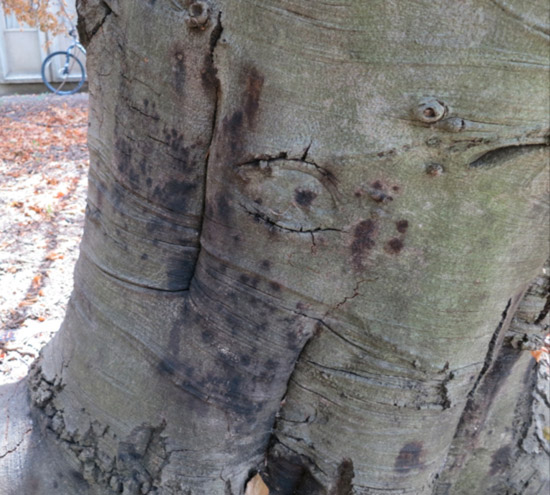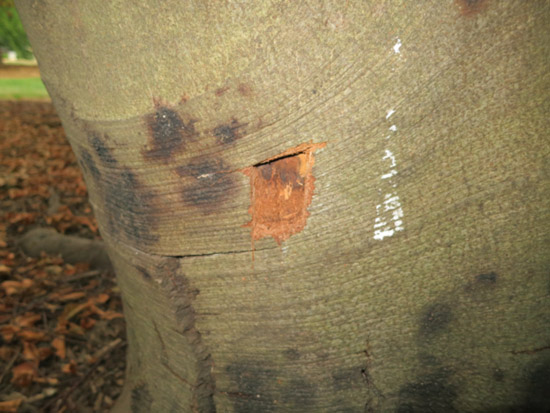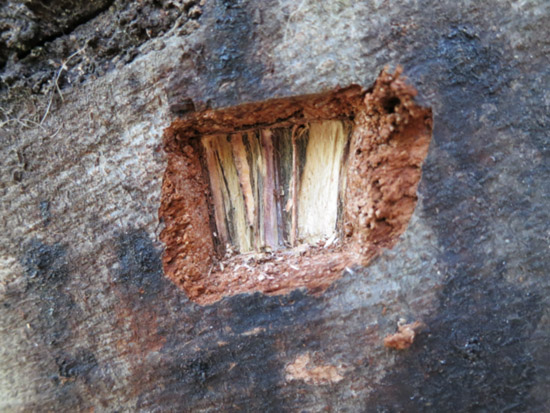Issue 15, August 27, 2012
Bleeding Canker on European Beech
Bleeding Canker is a potentially lethal disease to mature European Beech trees (Fagus sylvatica). Researchers at Cornell University have been working extensively with this disease and have identified three closely related species of Phytophthora that are involved. Phytophthora plurivora, P. pini and P. citricola all cause similar bleeding canker symptoms discussed below.
Symptoms
Bleeding cankers appear as dark-colored areas with wet-looking or sappy material slowly oozing from the cankers (first image). The lower portions of the trunk are usually first to be infected and show symptoms, but the cankers can occur several feet above the soil line.

Stained dark-colored bark associated with bleeding canker disease on European beech.
Bleeding cankers can severely damage the aesthetic value of the beech tree's bark. However, the greatest damage occurs beneath the bark where the pathogen attacks and kills the cambial areas, causing damage to outer xylem tissues. Removing the cankered bark reveals discolored cambial tissues (second image). Cambial tissues will also show a characteristic reddish-pink discoloration (third image). Purple-leaved cultivars are reported to have a more pronounced pink coloration to infected cambial tissues.

Bleeding canker with bark cut away to reveal discolored cambial tissues.

Close-up of bleeding cankers. Bark cut away to reveal pinkish-red tissue discoloration.
As the bleeding canker expands, it essentially girdles the tree. Foliage in the canopy of infected trees may appear sparse with dieback, chlorosis and wilted leaves. Severe infections may result in the tree's death (fourth photo).

European beech tree killed as a result of bleeding cankers. The tree was planted on the high point of the slope. Drought and water stress likely contributed to disease development.
The European beech appears to have some natural defenses against the pathogen. Many trees have been found with cankers that appear to have been walled-off by the tree. Stressed trees with subsequent weakened defenses are believed to be at greatest risk. Drought seems to be at the top of the list of stresses that favor the disease development.
Disease Management
- Scouting European beech trees can help catch the canker early during disease development. The dark-colored cankers can be easily spotted on most trees. Fortunately, this disease is rare and much less common on American beech (Fagus grandifolia).
- As with most disease prevention strategies, avoid stressing the tree. The current severe drought may put many mature beech trees at risk. The dead beech in the fourth image (above) was planted at the top of the slope. Bleeding canker combined with two successive years of drought may have finished the tree off. Irrigating at-risk trees may be beneficial. A light layer of mulch will help maintain adequate soil moisture. Avoid suffocating the roots with heavy layers of mulch.
- Fungicides are available for preventative use and to slow the spread of cankers. Cornell University has reported good results from bark drench applications of systemic fungicides containing the active ingredient mono- and di-potassium salts of phosphorous acid. The current recommendation is to mix 1 part fungicide with 1 part water. A bark penetrating surfactant such as Pentra-Bark should be added to the mix. As always, read the labels on both products before applying.
(Travis Cleveland)
Author:
Travis Cleveland